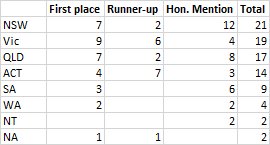Digital is now well-embedded in virtually every agency and council at every level of government in Australia and New Zealand, and mobile & online have now been the primary channels for citizens to engage governments for almost ten years.
My predictions back in 2006 that all government communicators would have to understand digital tools as part of their engagement mix have largely been realised, with social being well integrated into agency communications. Albeit this is still far too outbound only for my taste in many organisations & there's continuing overly restrictive social media rules in place for public servants via the APSC which I know are causing a number of quality candidates to avoid applying for government roles.
Cloud is widespread, if not fully understood or embraced and open source and open data are part of the landscape - although there's not been the full value yet realised in my humble opinion.
Digital as a profession has splintered into a range of specialist roles, with clear career paths and their own conference circuits and communities of practice. Meanwhile digital savvy senior executives are no longer as rare as hen's teeth, albeit not yet as common as Canberra taxi drivers with political opinions to share.
Design Thinking and Innovation are everywhere (even buzzwords), and Agile has climbed out of ICT into policy and service delivery spaces, adding value in most places it touches.
It's true that many agencies are still in the throes of Digital Transformation - but this has moved largely on from updating foundational systems to true value creation.
In sum government has advanced in how it understands and uses digital to improve governance and service delivery while reducing costs, however similar to the old tale of King Midas, Digital has become more Bureaucratised - something government does to everything it touches - fit into the hierarchy and tamed, rather than transforming the basis of how agencies govern.
As such I think it is time to stop talking 'digital transformation' and start talking 'purpose-based transformation'.
Previous Digital Transformation often (incorrectly) put the emphasis on the Digital rather than the Transformation, being more of a lift & shift approach where governments supplemented or replaced physical transactions and locations with digital equivalents.
There was some service transformation undertaken, with each process looked at individually, or even within the context of specific personas and life events, to redesign them to be slightly easier to use. However there haven't been the mechanisms in place (structure, financing, capabilities or legal frameworks) to reinvent the relationship between government and citizen, or government and stakeholder, or government and supplier.
As a result, despite shiny new online transactional services, supporting systems and growth in their use, there's still overall a lack of clarity in many agencies about how these transactions meet or support the overall purpose of the agency itself. While the transaction might be seamless and secure, what is the 'price signal' it gives to citizens using it?
Are citizens nudged to be good auto-shoppers, self-servicing their needs, or is there a bigger purpose being met in how these digital services help citizens to meet their actual needs, rather than complete a form and press a button?
Purpose-based Transformation, which I raised in a conversation over lunch with Pia Andrews this week, is all about getting back to understanding the roots of why an organisation exists and what is is trying to achieve. It is then about testing whether the current organisational design has a laser sharp focus on fulfilling that purpose through their every interaction - whether with citizens, organisations or other agencies.
Revisiting, and restating that underlying purpose and validating whether the organisation is currently fit for it becomes the first step in a transformation approach that builds on everything we've learn through digital and focuses it on the value proposition of the organisation, rather than the value stream from a specific service or process.
Taking a purpose-based approach allows an agency to think about all its procedures, processes, services and systems from a different perspective. One that is ultimately user centric through a focus on why the organisation exists and expressly seeks to achieve.
In this Purpose-based transformation context, Digital becomes an enabler of the approach and new experiences, rather than an end in its own right.
The goal is measured based on how well the purpose is delivered, rather than on the take-up and cost-savings from transactions.
The outcome of such a Purpose-based Transformation is a redesign of the structure and organisational procedures, systems and services - root and branch - leveraging digital to rethink the entire organisation from the ground up, not simply for specific processes or systems.
Imagine what could be achieved with a purpose-based transformation to address some of the underlying challenges that digital transformations have sometimes simply wallpapered over.











